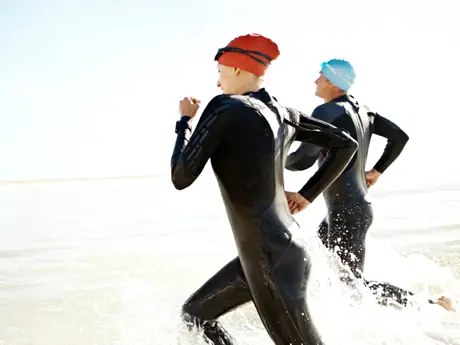Fast Finish
When Khalid Khannouchi was setting a pair of marathon world records in 2002, his coach and wife, Sandra, made it known that one of his staple workouts was a long run of about 20 to 22 miles in which Khannouchi would run the last two at a progressively faster pace, moving through half-marathon to 10K to 5K race pace in the last 10 to 15 minutes.
Although it is a challenge to change gears like this after being on your feet for a couple of hours, the benefit lies mainly in calling into play type IIb (fast glycolytic) muscle fibers, goading them into assuming a more endurance-oriented character.
In long events—particularly those in which the running component is at the end—it is vital to maximally train each fiber type in a way that allows it to contribute to long-distance performance. No matter what, your type I and type IIa fibers will always do the lion's share of the work in distance races, but by forcing your type IIb fibers to shoulder some of the load, you become a more economical and a more capable specimen overall.
A sample run for the athlete in the above example might be 16 to 18 miles, with the last two done at a pace starting at about 7:30 and dropping to 7:00 in the final three to five minutes.
Marathon Pace
Mathematically, this type of long run is something of a compromise between the other two. It is also the most taxing, so ideally it should be performed at the end of an otherwise low-key week and not within three weeks of an important competition.
This run reinforces specificity of pace and effort. Although you won't come close to your fastest marathon at the end of an Ironman (or your fastest open 10K at the end of an Olympic-distance triathlon), it's still crucial to do a substantial amount of training at ideal marathon intensity so that the effort level is familiar to you during competition even if your pace is slower.
The amount of running to do at marathon pace varies according to your experience and the type of event. If you're aiming for an Ironman, you'll want to build up to runs of 16 miles that include around 12 miles at your optimal marathon pace, placed at the end of the run.
Olympic-distance triathletes—almost all of whom will be racing, if not running, for well over two hours—should shoot for at least eight miles at marathon pace at the end of 14- to 16-milers. The slower portion of the run should be done at the same comfortable pace at which you do your steady-state long runs.
Putting It Together
A training regimen that includes each of these types of long runs has you going long every week and rotating through each type. The basic, steady-state long run is the longest run you'll do in each cycle, the fast-finish run the second-longest, and the marathon pace run the shortest (although interchanging the latter two has never been known to kill anyone).
So, in tabular form, our 3:30 candidate follows a plan like this one:
| Week | Distance | Specs |
| 1 | 15 miles | Last 6 miles in 48:00 |
| 2 | 17 miles | Last 1.5 miles in 11:00 (7:30, 3:30) |
| 3 | 19 miles | In 2:50:00 to 3:00:00 |
| 4 | 16 miles | Last 9 miles in 1:12:00 |
| 5 | 18 miles | Last 2 miles in 14:30 (7:25, 7:05) |
| 6 | 20 miles | In 3:00:00 to 3:10:00 |
The next two columns will address the other types of runs included in this training system and will culminate in an integrated training scheme applicable to runners and triathletes at all levels.
Continued in The Medium-Long Run: A Triathelete's Secret Weapon
Kevin Beck is a senior writer for Running Times and edited the book Run Strong (Human Kinetics, 2004).
Related Articles:
- 2
- of
- 2
Get ACTIVE on the Go


Couch to 5K®
The best way to get new runners off the couch and across the finish line of their first 5K.
Available for iOS | Android







Discuss This Article